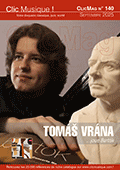 Le répertoire est fascinant, la voix est belle, l'accompagnement et les arrangements sont agréables... Alors, d'où vient le malaise avec cet album ? C'est justement qu'il est trop joli, trop poli pour être honnête, pas assez canaille. On entend des romances, pas les grivoiseries, les chants d'amour ni les protestations politiques ou sociales, ni les contes fantastiques ou burlesques ; on entend une charmante soprano, pas les lavandières de Vomero, pas les pêcheurs de Naples, pas les lazzaroni, pas les compagnons de Masaniello. C'est tout juste si le ton s'anime avec le dernier morceau, Lo Guarracino, burlesque histoire de la castagnole qui voulait se marier avec la sardine, mais dont l'histoire se termine par une bagarre généralisée entre tous les habitants des mers...Et le narrateur au gosier desséché qui demande à boire. Mais le plus triste dans cet album est l'indigence du livret, d'autant plus regrettable que le napolitain est difficile à comprendre même pour un italophone. Personne, à part les Napolitains, les initiés et les heureux lecteurs de ClicMagazine ne peut deviner que Carolina est l'épouse de Ferdinand Ier, roi bourbon des deux Siciles, et que non contente de prendre ses amants dans l'entourage de son époux et de les faire empoisonner, elle se mêle un peu trop des affaires du royaume ; que Cannatella, dans un dramatique conte de fées, était la fille d'un roi qui aurait voulu avoir un garçon ; que Lu Cardillo est un chardonneret chargé par l'amant de porter à sa maîtresse un message d'amour lourd de jalouses menaces ; que Cicerenella se promenait seule à cheval la nuit sans protection, etc ...Mais on peut tout à fait aimer cet album pour la beauté du chant de Letizia Calandra, de la guitare de Valerio Celentano et de ses arrangements... (Marc Galand)  This album The Anonymous Neapolitan is a continuation of Calandra’s journey to Naples of old, that inexhaustible font of timeless stories, melodies and poetry. From its earliest origins the Neapolitan canzona or song has been bound up with the life of the people of Naples and their innate desire to express their deepest feelings through song and poetry. For at least three centuries, the songs were only ever handed down orally and many of them were lost in the city’s alleyways and taverns, disappearing into the very air of Naples. It wasn’t until the mid-19th century that all this material was collected, transcribed and organized for the first time and Neapolitan song became fashionable among all classes of Neapolitans as well as with broad swathes of visiting tourists who also fell in love with them. For this Neapolitan anthology, Calandra and Celentano have selected 21 pieces, all by anonymous authors, including a brief instrumental insert from the very distant past, namely the Seikilos epitaph, likewise, of course, anonymous. Following the thread of feeling, Calandra and Celentano have gone back in time all the way to Ancient Greece with this musical fragment discovered in Anatolia in 1883, whose dating ranges from the 2nd century BC to the second century AD, making it the oldest complete piece of music that has found a place in their repertoire. This age-old melody has an innate, almost indescribable beauty, solidifying Calandra and Celentano’s decision to feature it as an introduction to the song that’s believed to be the oldest in the Neapolitan tradition, the ‘Ritornello delle Lavandaie del Vomero’ (Song of the Washerwomen of Vomero). To close the CD: an authentic masterpiece of the Neapolitan dialect repertoire from the 18th century, ‘Lo Guarracino’, whose text describes various characters with abundant invention and sophistication. Nonetheless this can only be attributed to the work of an anonymous poet, whose geniality and refinement are all we know about him or her. There is a sense of continuity between this project and Calandra’s previous Naples-related albums for Brilliant Classics: Scarlatti and the Neapolitan Song, Donizetti: Nuits d’été à Pausilippe and Erotica Antiqua: Neapolitan Villanellas. But most of all it represents a sentimental journey across the centuries and through our fresh imaginings of a hugely important musical heritage that must not be lost.
 |
